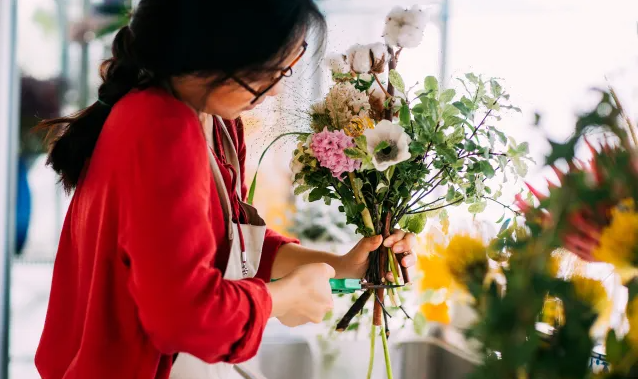
As extreme weather conditions threaten flower production and transportation emissions come under scrutiny, the demand for more environmentally friendly alternatives is growing. But can an industry historically dependent on resource-intensive cultivation truly go green?
A Climate Crisis for Flower Growers
For over two decades, Dr. David Bek has studied what sustainability means in the flower industry. His conclusion? The most sustainable flower is one grown naturally in a local garden, fed by rainwater. However, for the global cut flower trade, such an approach is far from feasible.
"The industry is undergoing a significant shift," says Bek, a professor of creative economies and ecological sustainability at Coventry University. "Environmental issues—especially erratic weather patterns—are creating major challenges for growers."
The impact of climate change is already evident. In Kenya, where a significant share of Europe's roses are grown, rising temperatures, irregular rainfall, and droughts are threatening yields. According to Mahsa Yeganeh from the Fairtrade Foundation, these challenges are increasing production costs and putting thousands of flower farm workers at risk.
Even in Europe, flower growers are feeling the strain. Bek recalls a conversation with a small-scale grower in Scotland who decided against expanding operations due to the heightened risk of storm damage. Large-scale greenhouse operations in the Netherlands—the heart of Europe's flower industry—are also struggling with soaring energy prices.
Greenhouses and Pesticides: A Mixed Picture in the Netherlands
The Netherlands supplies around 70% of Europe's flowers, with much of this production occurring in high-tech greenhouses. While these facilities allow for year-round cultivation, they are also highly energy-intensive.
Some Dutch municipalities, including Zutphen, Amersfoort, and The Hague, have gone so far as to ban flowers at public events, citing concerns over pesticide use. Research has revealed high levels of chemicals in Dutch flowers, including substances banned under EU regulations.
Still, the Netherlands is also at the forefront of sustainable innovation in floriculture. "Reducing energy consumption is a key priority," says John Janssen, a project leader at SMK, a Dutch foundation promoting sustainability in agriculture. Efforts include decreasing reliance on natural gas heating, optimizing electricity use, and minimizing chemical crop protection.
The Environmental Cost of Transportation
Despite widespread concerns over pesticide use, the biggest environmental impact of cut flowers comes from transportation. Flowers flown from Kenya, Colombia, or Ecuador have a significant carbon footprint. However, the energy demands of greenhouse cultivation in the Netherlands can be just as problematic.
Recent studies indicate that Fairtrade roses from Kenya, even when transported by air, have a lower energy footprint than Dutch-grown roses due to the absence of artificial heating. When shipped by sea, the emissions savings are even greater. Kenya's warmer climate allows for natural cultivation, reducing energy-intensive interventions.
To tackle transport emissions, the industry is increasingly looking to sea freight as a viable alternative. This shift, combined with the push for greener energy in European greenhouses, represents a promising step toward reducing the flower trade's carbon footprint.
Fairtrade and Sustainable Certifications: A Way Forward?
Many consumers are now seeking more sustainable flower options. Fairtrade certification ensures that flowers are grown with lower pesticide use, responsible water management, and fair wages for workers. Around 38,000 Kenyan flower farm workers are employed at Fairtrade-certified farms, which prioritize environmental and social sustainability.
For those preferring locally grown flowers, certifications such as ‘On the Way to PlanetProof' in Europe guarantee more eco-friendly production methods. However, awareness and uptake of these labels remain low. While 90% of Europeans express a preference for locally grown flowers, only one-third actively purchase them, according to a 2022 survey by the Flower Council of Holland.
Disruptive Innovation in the Dutch Market
Some Dutch growers are setting new benchmarks in sustainability. Porta Nova, a major rose producer near Aalsmeer's flower auctions, has achieved a 90% reduction in carbon emissions per stem through 100% wind energy, LED lighting, and closed-loop water recycling.
"The Netherlands can't compete on price alone," says Janssen. "Our future success lies in sustainable production and social responsibility."
A Greener Bouquet: What Consumers Can Do
While no perfect solution exists, consumers can make more informed choices:
-
Support Fairtrade Flowers: These guarantee better conditions for workers and lower environmental impact.
-
Choose European-certified flowers: Labels like ‘On the Way to PlanetProof' indicate more sustainable practices.
-
Buy from local growers: Small-scale, seasonal flower farms provide eco-friendly alternatives to mass imports.
Sammie Hall, a Yorkshire-based flower grower and member of the UK's Flowers from the Farm network, believes consumer awareness is key. "People don't realize the environmental cost of supermarket flowers. We need to re-educate them about seasonality and sustainability."
As climate change continues to disrupt the global flower industry, sustainable innovations and consumer choices will shape its future. Whether opting for Fairtrade roses or locally grown wildflowers, a greener bouquet is now within reach.